AT this time of year, a steady stream of cars heads up Tintinhull Road about 15 minutes from Tamworth. Every day Vicki Quast opens the family’s retail turkey shop at 8am and is flat-out until she closes the doors nine hours later. Families need their big Christmas bird to feed the friends and relatives who’ll descend over the festive season, chefs order them for office parties and bosses buy them as a thank you gift for workers.
“It ebbs and flows from year to year what people buy,” Vicki observes. “It often depends what recipes are appearing in the women’s magazines. Two years ago, there was a great demand for turkey breast because a magazine had published a recipe for butterflied turkey breast. That was interesting. The trick is ensuring there’s enough to meet demand.”
Keeping the turkeys in the family
Quast Turkeys is a family business that was started in 1950 by current owner Col Quast’s father, Col Senior, who was then just 17 years old. By the 1960s, the North West NSW business was producing 1,800 turkeys a month. Now it’s up to 60,000 a year and Quast is Australia’s third-biggest turkey producer after Ingham’s and Steggles.
But Col doesn’t want to compete against those two bigger players so has no plans to expand – a strategy that allows him to look after every part of the operation in-house, from insemination to butchering and everything in between.
_preview.jpg) Vicki and Col Quast are keeping it in the family.
Vicki and Col Quast are keeping it in the family.
Col’s son Colin James, who also works on the farm, is largely responsible for growing the grain to feed the turkeys. Manure from the turkey sheds is used on the crops and straw from the crops is turned into bedding, so nothing is wasted. Surplus from the meat processing is rendered and turned into meal for pet food.
“While about three-quarters of Quast’s annual production ends up on Christmas tables, fulfilling that demand is a year-round process."
While about three-quarters of Quast’s annual production ends up on Christmas tables, fulfilling that demand is a year-round process. Workers take their holidays in January, but by February they’re back in production stocking up the farm’s massive freezing room, which can hold 250 pallets and about 240 tonnes of turkey.
The Quasts run two flocks of breeders – about 750 in all, and since the late 1970s they’ve all been artificially inseminated. “We artificially inseminate once a week,” says Col. “Turkey semen doesn’t keep so we milk the toms [males] and use it straight away. Inseminating about 700 females is a three-hour job for four or five people. You just hook in and do it.”
RELATED ARTICLES ON FAMILY BUSINESS:
-
Industrious beekeepers nurture thriving family business
-
Booroomooka beef: 160 years of farming
-
Bucking traditions breeds innovation for Dubbo sheep farmer
-
Going for growth with goats
Managing the turkey farm
The resulting eggs are collected five times a day and kept in a cool room so they remain dormant and can be set and therefore hatched at the same time. That takes exactly 28 days and the poults (chicks) go straight into a warm brooder house. “Turkeys need a lot of heat,” explains Col.
“The poults remain there for about five weeks, then they’re either moved to a free-range paddock or a barn where they’re left to grow out.”
The barn-raised turkeys are kept in an open-sided shed with curtains on the side to keep the wind out, while about 1,500 paddock-raised birds are free to roam in a 0.8-hectare field. They are locked up at night to protect them from predators.
“We started doing paddock-raised because of consumer demand. The dollar is there,” says Col. “We’ll probably do around 5,000 for Christmas. There is a biosecurity risk with wild birds, but we haven’t had a problem so far.”
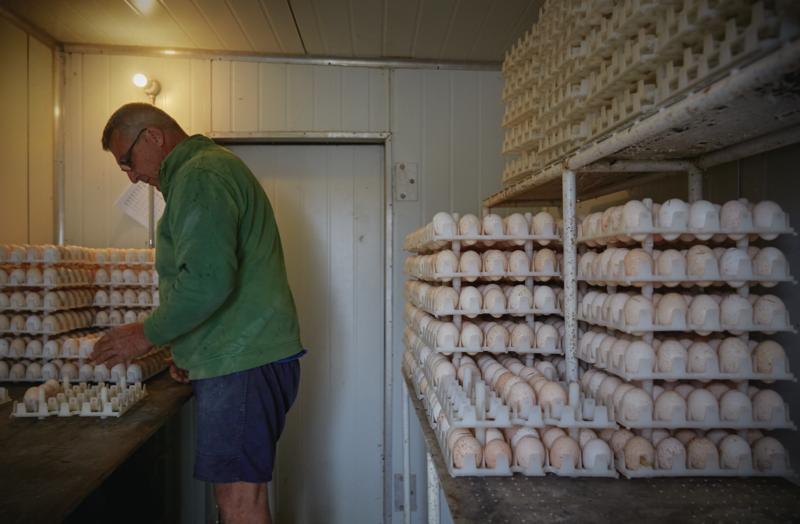 Col Quast inspecting one-day-old eggs in the cool room. Eggs are collected 5 times a day.
Col Quast inspecting one-day-old eggs in the cool room. Eggs are collected 5 times a day.
All the birds get the same feed and because today’s turkeys reach mature weight so fast – a female reaches a 3kg table weight in just eight weeks – diet is a science.
“Turkeys require a high-protein diet compared to most animals,” explains Col. “From day one, they’re fed a 27% protein diet for growing, but as they get older we increase their energy intake so they start to lay down a little bit of fat. By the end, they’re down to a 14% protein diet. Feed consists of protein meal, grains, vitamins and minerals and we also add a little bit of vegetable oil.”
Hardship of drought pushes turkey prices up by 10%
In a normal year, the farm produces almost enough wheat to feed the flock – impressive, considering 60,000 turkeys will gobble up 1,300 tonnes of grain. However, this year’s drought means Col has had to buy grain in and has raised prices by 10% to cover the extra cost.
Clearly that’s a worry, but customers have been supportive. Col sells to wholesalers, retail butcher shops and agents all over the country, and spends some time away building relationships with his customers.
“We try to keep that personal touch. This is a family business and people like that. It’s interesting that when I have to explain I need to increase my prices because of the drought they’ve all said: ‘That’s fine, Col. We’re happy to look after you. You’ve looked after us. Let’s do it.’”
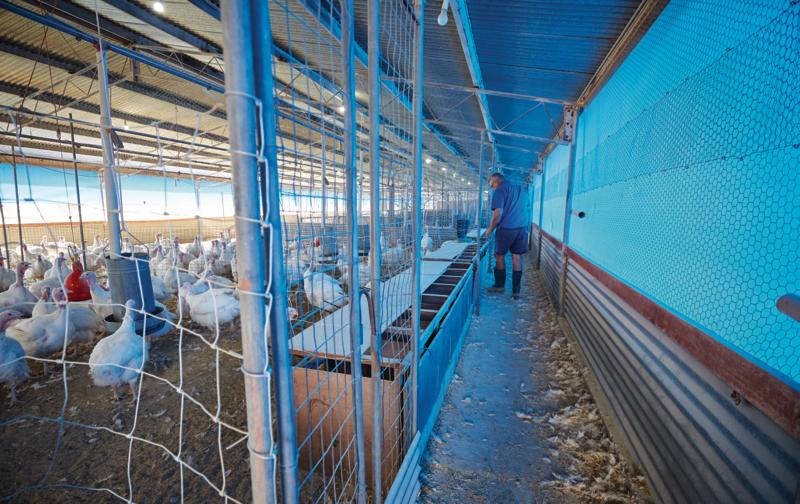 Col collects eggs from the breeding shed.
Col collects eggs from the breeding shed.
Col began working with his dad when he was 18 and since then he’s seen numerous improvements and innovations.
“There’s better technology,” he says. “ Our brood sheds, for instance, are run by state-of-the-art computers so that from day one, you set the temperature and it controls ventilation and it’s all better for the birds’ health.”
He also puts a lot of
emphasis on biosecurity.
“In some ways it’s difficult because we’re an old farm and we have a processing plant here, but having said that we don’t have reps or servicemen who might have been on another turkey farm. The only thing that comes in here is a freezer truck to take turkeys out. Everything else is in-house. We’ve built truck washes and everyone who goes into the sheds showers first. I’d like to think we’re doing everything we possibly can.”
By far the biggest innovation Col has seen is the importation of breeding stock. “We used to employ geneticists and do a lot of genetic work here [in Australia] but the improvements from overseas are so great, there’s no point now,” he says.
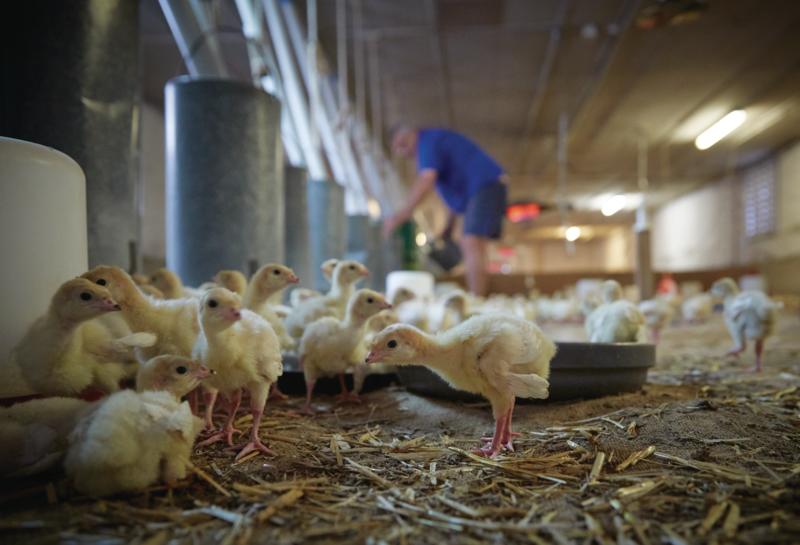 5-day-old chicks in the brooder house.
5-day-old chicks in the brooder house.
“Previously, the youngest we’d have processed a bird was 15 weeks and we’re now down to eight weeks to get that same size. Feed conversion is better by far, they’ve got more breast meat and they haven’t got the long, lanky drumsticks they used to have.
“In a good meat bird line, you look for leg strength, gait and breast muscle percentage – because that’s where the money is in a turkey. Egg-laying birds are selected for reproduction.
“In a good meat bird line, you look for leg strength, gait and breast muscle percentage – because that’s where the money is in a turkey. Egg-laying birds are selected for reproduction.”
“The reason it’s not done here any more is to do with selection intensities – they produce so many birds overseas they leave us for dead. It’s the same with chickens. There are virtually no chicken genetics going on in Australia anymore. They just bring in the new genetics and away you go.”
Is importing turkeys feasible?
Could there be any problems with importing birds? “I don’t see any unless there was a major disease outbreak, but we get them from all over the world,” Col says. “Traditionally, they come from America but there are genetics in a lot of the European countries now as well.
“Some people claim they grow too quickly and can’t carry themselves. They say: ‘Oh that’s why they have to be artificially inseminated’, but we’ve been artificially inseminating birds for 30 years. Natural mating is horrible. They rip each other to pieces. Insemination is much more humane.”
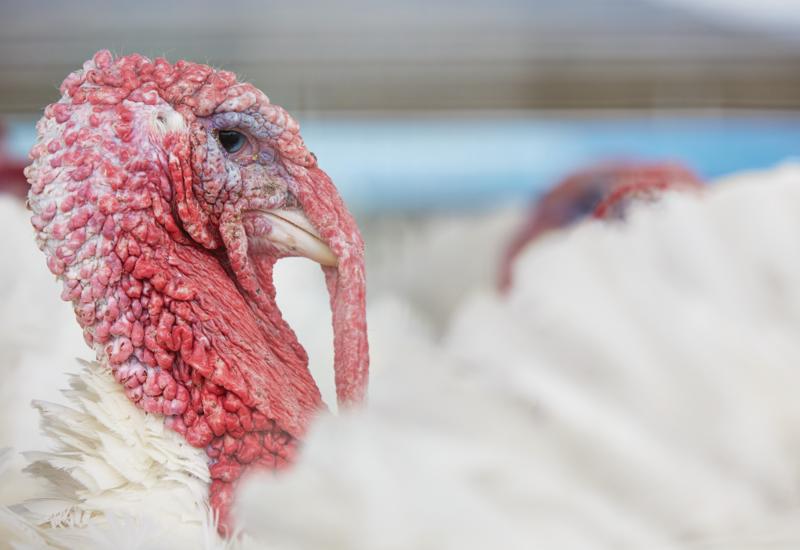 A 32-week old male breeder.
A 32-week old male breeder.
Some people claim they grow too quickly and can’t carry themselves. They say: ‘Oh that’s why they have to be artificially inseminated’, but we’ve been artificially inseminating birds for 30 years. Natural mating is horrible. They rip each other to pieces. Insemination is much more humane.”
On that subject, Col reckons catching birds to inseminate them is about the only physical work he has to do these days. Even cleaning out sheds is now mechanised.
The technology behind turkey farms
The only area where he’s not as automated as he’d like is processing, but the size range means processing turkeys is complicated compared to other poultry. Typically, a whole table bird will weigh 3-6kg. However the dressed weight of a male can be as much as 35kg.
“They take a bit of handling and it creates an issue because you require such a big variance in the capacity of your machinery. It’s something we’ll update down the track but we need to work through it.”
Obviously few people have the capacity or need to cook a 35kg bird that would feed 70 people, so the large ones are butchered down for small goods. Turkey enjoys a reputation as a healthy, lean meat and as a result products such as turkey rissoles and sausages are gaining popularity.
 Boning the sixteen-week old turkeys in the processing plant.
Boning the sixteen-week old turkeys in the processing plant.
The Quast family is keen to expand their range and, with this in mind, Colin James has been experimenting with smoked-turkey products.
It’s not surprising that after nearly 70 years in business the Quasts have built up a loyal fan base. Some customers have been putting in orders for 40 years. But Col says they don’t sell to supermarkets.
We’re not big enough,” he says. “I don’t want to be dictated to and pay for shelf space and also there are two big supermarkets and two big turkey producers so I’m really not interested. I’m happy with the way we sell our birds.”
As he prepares for Christmas, Col reflects on how lucky he is to have a business he’s built up with his own family. “I’ve often said one of the best things I ever had was that I got to work with my father and it’s great that my son is now working with me.”
Vicki agrees and to her mind there’s nothing that says family celebration like a turkey on the dinner table. “That’s how we promote it – a time for family and friends,” she says. And the job of promoting Quast turkeys doesn’t stop at Christmas, Vicki adds. “I must remind people about ordering one for Easter.”
READ MORE CHRISTMAS FARMING STORIES:
-
Christmas tree farmer boosts business with space-age machine
-
Oyster growers thrive despite environmental crisis
Turkey welfare, beak trimming and ethical farming
Perhaps because they feature on so many Christmas cards, dreading the arrival of Santa, few animals come under the welfare microscope as intensely as turkeys. As a result, says Col, there’s a keen awareness among his staff about bird welfare and the entire farm is regularly audited.
This year he contributed to an Animal Health Australia (AHA) public consultation on poultry farming aimed at drawing up new standards and guidelines for poultry welfare.
Understandably, some in the industry – especially caged-egg producers – are awaiting the results of that with trepidation.
“It’ll be very interesting, because we can’t keep everyone happy,” says Col, who has few issues apart from the discussion around beak trimming. This involves the partial removal of the tip of the beak. “It’s sort of similar to the mulesing of sheep but I don’t see we have other options,” he says.
“We have tried to go without but the cannibalism in the birds is horrible and the free-range birds are worse, if anything, than the barn-raised ones. Turkeys are known for their cannibalism, that’s just the way it is.”
 Chicks with their beaks trimmed, to prevent cannibalism.
Chicks with their beaks trimmed, to prevent cannibalism.
There are non-invasive infra-red machines that trim beaks, causing the trimmed part to fall off a couple of days after treatment. But these machines are all leased, come from overseas and are only available to big operations, so the Quasts currently use hot blading.
On the whole, Col says, the poultry industry is happy to have new guidelines and legislation. “If people are doing the wrong thing they should be prosecuted, but it’s hard to have everything as standard. The beak trimming for me is difficult but I don’t have too many other issues. I know some of the bigger companies have issues with stocking densities because they rely on contract growers who need big densities to make money, but we don’t do that. Our stocking densities are about 10kg under what AHA wants as a standard so I’m quite happy to have that.”
How to cook a Christmas turkey
Vicki Quast shares the turkey roasting method she was taught by her mother-in law – passed down over 60 years on the land.
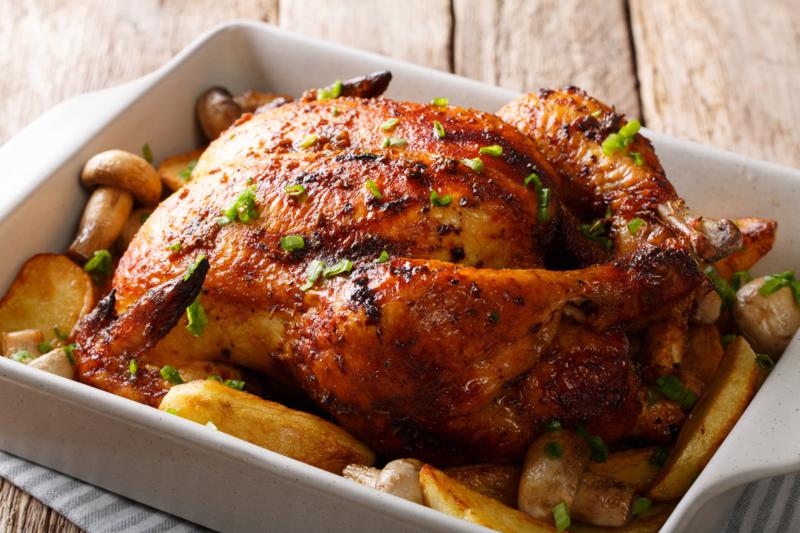
- Cooking time for a whole turkey is 45 minutes per kilo, plus 15 minutes for browning.
- Place a cake cooling rack in a baking pan and lay three generous strips of aluminium foil across it – enough to be able to wrap around the bird and fold securely at the top. Preheat the oven to 160℃ and set it to bake, not fan-bake. If your oven doesn’t give you a choice, lower the temperature by at least 10 degrees. This will ensure the meat remains moist and tender.
- Use your favourite stuffing to firmly fill both ends of the bird. Place turkey in the centre of the foil and rub oil all over the skin. Fold in the ends of the foil then bring the longer pieces up to meet at the top and scrunch them over to seal the turkey inside.
- Add water to the baking pan, making sure it does not touch the foil around the turkey, then slide the bird into the oven.
- Once cooked, remove the turkey from the oven and carefully unwrap the foil, being careful to avoid steam burn. Increase oven temperature to 200℃ and switch to fan-bake if possible. Retract the foil as far as possible, return the turkey to the oven and cook for a further 15 minutes until brown. If any parts brown too quickly, cover with oil-coated foil to protect during the final stage.